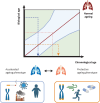Mechanisms and markers of lung ageing in health and disease
- PMID: 40701639
- PMCID: PMC12284718
- DOI: 10.1183/16000617.0233-2024
Mechanisms and markers of lung ageing in health and disease
Abstract
Ageing significantly impacts lung function and increases susceptibility to chronic lung diseases. The lung is a complex organ with multiple cell types that undergo cellular age-related perturbations or hallmarks. As knowledge of ageing mechanisms has progressed, we have a better understanding how intracellular adaptations impact cellular crosstalk and integrate to increase the susceptibility to age-related diseases in the lung. Herein, we discuss the prospects of exhaustion of lung progenitor cells, disrupted lung cell plasticity, perturbation in fibroblasts, impaired adaptive immune responses and alterations in lung microenvironment in the promotion of ageing and age-related lung diseases. Additionally, the ageing process trajectory of the lung depends on a combination of biological, genetic, metabolic, biomechanical and sociobehavioural factors that range from protective phenotypes to accelerated ageing phenotypes. We propose the concept of AgEnOmics, which expands the temporal dimension of lung ageing by distinguishing between chronological ageing and accelerated lung ageing phenotypes. Based on this concept, we define biomarkers of biological ageing that will help to define accelerated ageing and early interventions in biological ageing-related lung diseases.
Copyright ©The authors 2025.
Conflict of interest statement
Conflict of interest: Z. Miller, L-M. Twardowski and B.F. Reader have no conflicts of interest to disclose. M. Lehmann reports research funding from Boehringer Ingelheim as well as honoraria from Berlin Chemie and Ono Therapeutics outside of this work. A.L. Mora and M. Rojas report research funding from Boehringer Ingelheim and AstraZeneca outside of this work.
Figures





Similar articles
-
Genes and pathways underlying susceptibility to impaired lung function in the context of environmental tobacco smoke exposure.Respir Res. 2017 Jul 24;18(1):142. doi: 10.1186/s12931-017-0625-7. Respir Res. 2017. PMID: 28738859 Free PMC article.
-
Beyond classical collagen: basement membrane collagen IV in age-associated lung diseases.Eur Respir Rev. 2025 Jul 23;34(177):240192. doi: 10.1183/16000617.0192-2024. Print 2025 Jul. Eur Respir Rev. 2025. PMID: 40701642 Free PMC article. Review.
-
Short-Term Memory Impairment.2024 Jun 8. In: StatPearls [Internet]. Treasure Island (FL): StatPearls Publishing; 2025 Jan–. 2024 Jun 8. In: StatPearls [Internet]. Treasure Island (FL): StatPearls Publishing; 2025 Jan–. PMID: 31424720 Free Books & Documents.
-
Systemic pharmacological treatments for chronic plaque psoriasis: a network meta-analysis.Cochrane Database Syst Rev. 2021 Apr 19;4(4):CD011535. doi: 10.1002/14651858.CD011535.pub4. Cochrane Database Syst Rev. 2021. Update in: Cochrane Database Syst Rev. 2022 May 23;5:CD011535. doi: 10.1002/14651858.CD011535.pub5. PMID: 33871055 Free PMC article. Updated.
-
Systemic treatments for metastatic cutaneous melanoma.Cochrane Database Syst Rev. 2018 Feb 6;2(2):CD011123. doi: 10.1002/14651858.CD011123.pub2. Cochrane Database Syst Rev. 2018. PMID: 29405038 Free PMC article.
Cited by
-
Airway Extracellular Copper Concentrations Increase with Age and Are Associated with Oxidative Stress Independent of Disease State: A Case-Control Study Including Patients with Asthma and COPD.Antioxidants (Basel). 2025 Aug 17;14(8):1006. doi: 10.3390/antiox14081006. Antioxidants (Basel). 2025. PMID: 40867902 Free PMC article.
References
-
- United Nations Department of Economic and Social Affairs, Population Division. World population prospects 2022: summary of results. Last updated: 2022. Date last accessed: 1 October 2024. https://www.un.org/development/desa/pd/sites/www.un.org.development.desa... .
-
- Rutting S, Chapman DG, Farag CS, et al. Lung heterogeneity as a predictor for disease severity and response to therapy. Curr Opin Physiol 2021; 22: 100446. doi: 10.1016/j.cophys.2021.05.009 - DOI
Publication types
MeSH terms
Substances
LinkOut - more resources
Full Text Sources
Medical
Research Materials
